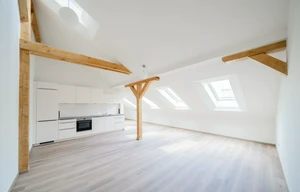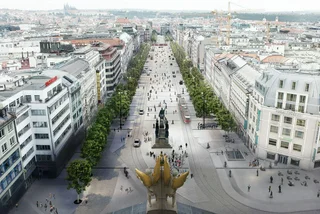One of the more treacherous intersections in Prague will become safer. The city has started to modify the intersection at the crossing of Legerova and Vinohradská streets to include two new pedestrian crossings, thanks to which thousands of people a day will no longer have to walk through an underpass that is unsuitable for wheelchair users, or risk their lives jaywalking across the busy highway.
The new intersection will put an end to the complicated journey to get to the other side of the north-south arterial road. The changes will not restrict car traffic, as traffic lights are already installed at the site and pedestrians will cross during the red light cycle.
The Legerova and Vinohradská intersection is an important junction on the border of the Prague Conservation Area and the Vinohrady neighborhood, with both the historical and new buildings of the National Museum buildings in the vicinity, and Wenceslas Square just beyond them.
The place is a natural transition between Prague’s New Town and Vinohrady districts. Approximately 21,000 people pass through the underpass daily. At the same time, 450 people a day cross busy Legerova Street, despite the lack of lights or a designated crosswalk.
“We should encourage the most natural movement in the city, which is walking. Tens of thousands of people walk between the two districts every day. There is no reason not to have crosswalks here when we have traffic lights and drivers waiting for the green light anyway. During that time, people will be able to cross the road,” Prague Deputy Mayor Adam Scheinherr, responsible for transit issues, said.
“Until now, it has only been possible to get to Wenceslas Square or Vinohrady via a dark underpass. Now, the traffic light technology is being regularly repaired and we are also planning to modify the tram line. On that occasion, we have also designed a pedestrian crossing that will not delay drivers on the main line," he added.
Scheinherr said in Facebook that the city was also making other intersections safer, such as the ones at Karlovo náměstí and near the Florenc bus depot.
Prague 2 Deputy Mayor Jan Korseska praised both the changes to the Legerova intersection and the planned tram connection from Vinohrady to Wenceslas Square.
“A barrier-free and comfortable connection between Vinohradská Street, Škrétova Street and Wenceslas Square is a long-standing wish of ‘the Dvojka.’ We very much welcome the easier connection of the pedestrian route as well as the tram line and we consider it one of our priorities,” Korseska said. Dvojka is the colloquial term for Prague 2.

The crossing is a continuation of the work being carried out in the vicinity of the National Museum, which includes the extension of the tram line, the extension of the pavements, and the landscaping of the park Čelakovského sady. It is a logical continuation of the cultivation of public space in one of the most important places in Czech history and the present, City Hall stated.
At the same time, the extension of the “sidewalk of death" between the Prague’s main train station Hlavní nádraží and the tram and metro stops at Muzeum and the new crossings create a simplification of the pedestrian connection between the railway and the metro. Until now, pedestrians walking from the station had to go around the crossing in a complicated way to get to the metro.

“Pedestrian level crossings have been newly restored in front of the Historical Building of the National Museum and it is logical to continue connecting the museum oasis to its surroundings in a natural and convenient way, I.e. on the surface,” Ondřej Boháč, director of the Prague Institute of Planning and Development (IPR Praha) said. The institute is in charge of the whole concept of transforming the surroundings of the National Museum.
The city plans further modifications of the tram line and its connection to the already laid track between the buildings of the National Museum, from where the tram will connect to Wenceslas Square and in the future also in front of the main station's ticket hall in Vrchlického sady. A temporary art exhibit of a large concrete block is currently located at the tracks in the museum oasis.












 Reading time: 3 minutes
Reading time: 3 minutes 


































